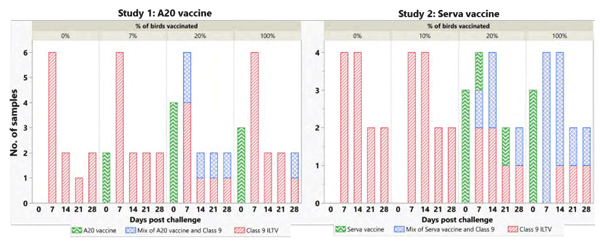Displacement of A20 and Serva Infectious Laryngotracheitis Vaccines Following Challenge with Virulent Virus
Published: March 15, 2024
By: A.M ASSEN 1, P.F. GERBER 1, S. WILLIAMSON 2 and S.W. WALKDEN-BROWN 1 / 1 Animal Science, University of New England, Armidale, NSW, Australia; 2 Birling Avian Laboratories, Bringelly, NSW, Australia.
We investigated the kinetics of vaccine (A20 and Serva) and wild-type (Class 9) infectious laryngotracheitis virus (ILTV) strains in dust samples after challenge as part of experiments investigating the level of protection provided by variable initial vaccination coverage against the adverse effects of virulent challenge.
Two isolator studies using day-old Cobb broiler chickens were conducted to test the effects of partial vaccination with A20 (Study 1, 15 birds/per isolator) or Serva (Study 2, 10 birds/per isolator). Variable proportions of chickens (0%, 7 or 10%, 20%, or 100%) were eyedrop vaccinated at 7 days of age. Virulent Class 9 ILTV challenge occurred on days 7 and 21 or 25 post-vaccination by the introduction of two ILTV-infected chicks per isolator 4 days after infection. Dust samples were collected within isolators and tested for ILTV DNA using qPCR. ILTV qPCR positive dust samples containing 104 ILTV genome copies or higher per µl (n = 110) were submitted to Birling Avian Laboratories for typing to differentiate between vaccine and challenge virus as described by Assen et al. (2022a).
Overall, vaccination with the A20 or Serva vaccine provided a high level of protection against the increase in shedding of the Class 9 ILTV following the challenge (Assen et al., 2022b). The virus types identified on different days post-challenge (DPC) are shown in Fig.1.
Figure 1 - ILTV strains identified by typing at different DPC in the two variable vaccination experiments.

While both vaccines markedly reduced ILTV shedding post-challenge, the Serva vaccine was detected for longer duration post-challenge than the A20 virus which was rapidly displaced by the virulent virus. This may provide additional opportunity for recombination between the Serva vaccine virus and other circulating strains. The ability to type ILTV in dust samples from chickens with potentially mixed infections (vaccine and wild-type virus) is a further useful epidemiological application of testing dust samples for ILTV DNA.
Presented at the 34th Annual Australian Poultry Science Symposium 2023. For information on the latest edition, click here.
References
Assen AM, Groves PJ, Etherington A, Gerber PF, Sexton M, Williamson S, Walkden-Brown SW (2022a) Avian Dis. 66: 1-9.
Assen AM, Yegoraw AA, Gerber PF, Walkden-Brown, SW (2022b) World Poultry Congress, 7-11 August 2022, Paris, France.
Content from the event:
Related topics:
Authors:
University of New England
University of New England
Recommend
Comment
Share

Would you like to discuss another topic? Create a new post to engage with experts in the community.








.jpg&w=3840&q=75)